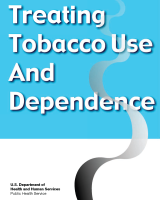NCBI Bookshelf. A service of the National Library of Medicine, National Institutes of Health.
This publication is provided for historical reference only and the information may be out of date.
This guideline contains strategies and recommendations designed to assist clinicians, smoking cessation specialists, and health care administrators/insurers/purchasers in identifying tobacco users and supporting and delivering effective smoking cessation interventions. These recommendations were made as a result of an exhaustive and systematic review and analysis of the scientific literature. The primary analytic technique used was meta-analysis. The strength of evidence that served as the basis for each recommendation is clearly indicated in the guideline. Public testimony and a peer review were also part of the guideline's development process, as well as a notice in the Federal Register inviting review. The guideline's principal findings are:
- Every person who smokes should be offered smoking cessation treatment at every office visit.
- Clinicians should ask and record the tobacco-use status of every patient.
- Cessation treatments even as brief as 3 minutes a visit are effective.
- More intense treatment is more effective in producing long-term abstinence from tobacco.
- Nicotine replacement therapy (nicotine patches or gum), clinician-delivered social support, and skills training are particularly effective components of smoking cessation treatment.[a]
Health care systems should make institutional changes that result in the systematic identification of, and intervention with, all tobacco users at every visit.
The guideline proposes strategies for carrying out each of its specific recommendations. For clinicians, these recommendations are (1) systematically identify tobacco users and document their status; (2) strongly urge all smokers to quit; (3) identify smokers willing to make a quit attempt; (4) aid the patient in quitting by helping with a quit plan, offering nicotine replacement therapy, giving advice, and providing supplementary information; and (5) schedule followup contact. Recommendations for smoking cessation specialists are (1) assess the smoker who has entered an intervention program; (2) use a variety of clinical specialists; (3) ensure that the program is sufficiently intensive; (4) use a variety of program formats; (5) include effective counseling techniques; (6) target the smoker's motivation to quit; (7) provide relapse prevention intervention; (8) offer nicotine replacement therapy; and (9) arrange followup contact. Recommendations for health insurance purchasers and health care administrators are (1) consider making tobacco assessment, counseling, and treatment a contractual obligation of the insurers and providers that sell services; and (2) ensure that institutional changes to promote smoking cessation interventions are universally implemented.
Contents
- AHCPR
- Guideline Development and Use
- Smoking Cessation Guideline Panel
- Acknowledgments
- Executive Summary
- 1. Overview
- 2. Recommendations for Three Target Audiences
- 3. Evidence
- 4. Promoting the Motivation To Quit and Preventing Relapse
- 5. Special Populations and Topics
- Glossary
- Contributors
- Attachment: National Network of Tobacco Prevention and Control Contacts
- Availability of Guidelines
- Strategies for the Primary Care Physician
- Strategies for the Tobacco Cessation Specialist
- Strategies for Health Care Administrators, Insurers, and Purchasers
- General Strategies
- References
Suggested citation:
Fiore MC, Bailey WC, Cohen SJ, et al. Smoking Cessation. Clinical Practice Guideline No 18. Rockville, MD: U.S. Department of Health and Human Services, Public Health Service, Agency for Health Care Policy and Research. AHCPR Publication No. 96-0692. April 1996.
- [a]
As this guideline went to press, nicotine nasal spray was approved for use in the United States by the Food and Drug Administration, joining the nicotine patch and gum as effective available interventions.
- Smoking CessationSmoking Cessation
Your browsing activity is empty.
Activity recording is turned off.
See more...

